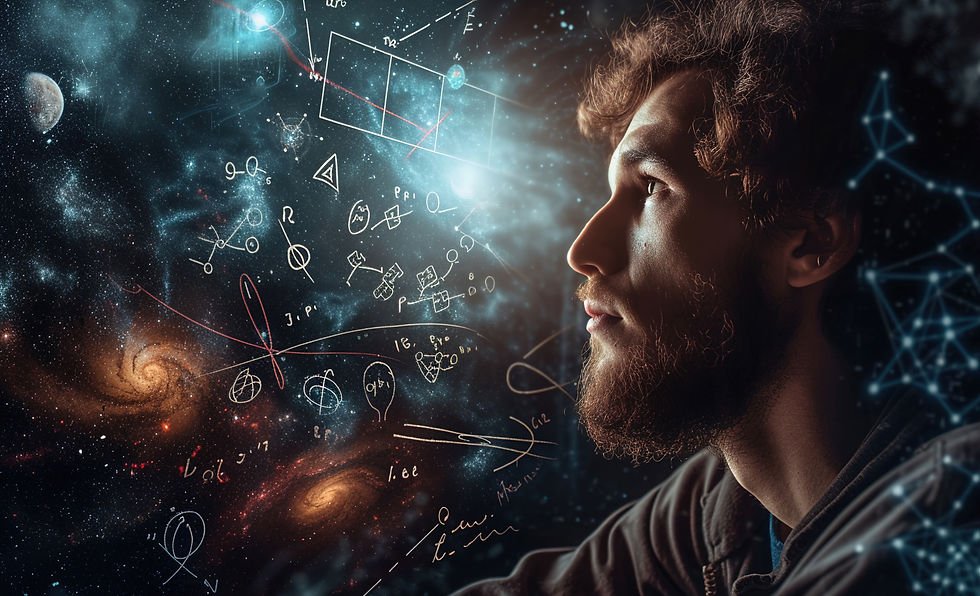Quantum Mechanics Explained Simply (But Without Losing Depth)
- Cristiano França Ferreira
- Aug 23
- 3 min read

Quantum Mechanics Explained Simply (But Without Losing Depth)
Quantum mechanics is one of the pillars of modern physics and, at the same time, one of the most counterintuitive theories ever formulated. It describes the behavior of the world at its most fundamental scale— atoms, electrons, photons, and subatomic particles —where the known rules of classical physics simply cease to apply .
In this article, you will understand what quantum mechanics is in an accessible, yet technical way, without falling into shallow simplifications or mystical terms - and discover why it not only works, but explains practically all of the material reality we know .
What is Quantum Mechanics?
Quantum mechanics is the physical theory that describes:
The behavior of particles at very small scales,
The energy states of atoms,
The interaction between light and matter.
It was born at the beginning of the 20th century to solve problems that classical physics could not explain , such as:
The spectrum of blackbody radiation (Max Planck, 1900),
The photoelectric effect (Einstein, 1905),
The structure of the atom (Bohr, 1913).
The word "quantum" comes from "quantum"—a discrete quantity. This reflects the fragmented nature of energy in this new universe: atoms don't absorb or emit energy continuously, but in specific packets called quanta.
The Foundations of Quantum Mechanics
1. Wave-Particle Duality
Every particle exhibits wave-like behavior—and every wave, under certain conditions, acts like a particle. Light, electrons, protons... all the fundamental elements of nature obey this ambiguous behavior.
2. Superposition
A particle can exist in multiple states at once—like being in two different places—until it is measured.
Example: the famous “Schrödinger’s Cat” is both alive and dead until someone opens the box.
3. Wave Function Collapse

By measuring a particle, we force it to "choose" a single state from among the possible ones. This is collapse: the superposition disappears, and we have a single result.
4. Interlacing
Two interacting particles can remain connected—so that one affects the other instantaneously, even over great distances. This defies the conventional wisdom of separation in space.
5. Uncertainty Principle
Formulated by Werner Heisenberg , it states that it is not possible to know, simultaneously, with infinite precision, the position and velocity of a particle . There is a fundamental limit to the precision of our knowledge.
Why is Quantum Mechanics So Weird?

It contradicts everything we're used to thinking. In the quantum world:
The particles do not follow well-defined trajectories ,
Causality may appear to be violated ,
Reality is only “decided” when we interact with it .
Therefore, Einstein was suspicious of the theory , saying:
“God does not play dice with the universe.”
But experiments always confirmed the theory - and never Einstein's arguments on this point.
Real-World Applications: It's Everywhere
Quantum mechanics may seem abstract, but it underlies many everyday technologies:
Transistors and microchips (the basis of all modern electronics),
Lasers (used in barcode readers, surgeries, fiber optics),
Magnetic resonance imaging (in hospitals),
GPS , which requires relativistic and quantum adjustments to work accurately,
Quantum computing , which promises to revolutionize data processing.
A Curiosity: You Use Quantum on Your Cell Phone
Your smartphone only works because semiconductor chips rely on quantum effects like quantum tunneling , where particles “pass through” energy barriers that, according to classical physics, should be impossible to overcome.
In other words, even without knowing it, you interact with quantum mechanics every day.
Quantum Mechanics ≠ Mysticism

It's important to emphasize: despite its mysterious nature, quantum mechanics is a rigorous, testable, and mathematizable theory . It does not serve as a justification for personal or magical beliefs , as seen in some pseudoscientific approaches.
Talking about “quantum thinking,” “quantum healing,” or “quantum coaching” without experimental or mathematical basis is a diversion from real quantum science —which requires evidence, peer review, and testable prediction.
Final Reflection: Understanding the Invisible

Understanding quantum mechanics is understanding the deepest fabric of the universe. It shows us that:
Reality is not made of certainties, but of possibilities ,
The observer is part of the experiment ,
The world is less solid and more relational than we imagine .
“If you think you understand quantum mechanics, you don't.” – Richard Feynman
And perhaps that is the beauty: embracing the unknown not as a mistake, but as an invitation to learn.



Comments